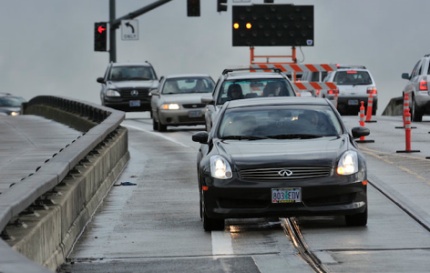
(Photos © J. Maus)
Tracks laid down as part of the Eastside Streetcar Loop project are having a major impact to traffic flow on and around NW Lovejoy Blvd. As part of work being done by activists with Active Right of Way to mitigate some of the negative impacts, I’ll be taking a closer look at the project in the coming days and weeks.
Today, I want to share a phenomenon that seems to be an unintended consequence of the new streetcar tracks that have been installed just a few feet away from the bike lane on NW Lovejoy as it heads westbound off the Broadway Bridge.
For some reason, the vast majority of people I observed prefer to straddle the streetcar tracks when driving in this location. The result is that their cars encroach onto — and in some cases into — the bike lane. This issue has come up in recent meetings of the AROW Streetcar Safety Working Group so today I went out to observe and take photographs.
Here’s what I saw…
Thankfully, when someone was actually using the bike lane, at least in one instance I observed, the person driving the car gave them plenty of room…
Before you comment, please realize I do not think this is the most pressing transportation safety concern in our city. I am merely wanting to draw attention to something that I’ve observed so there’s a public record that it’s happening and so the community has a chance to weigh in as to whether or not it deserves more attention.
It’s also worth noting that according to ORS 811.435, it’s illegal to “operate[s] a motor vehicle upon a bicycle lane or a bicycle path.”
So… Do you ride or drive in this location? If so, what do you think about this?

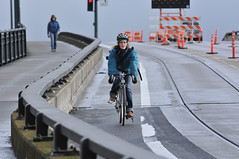

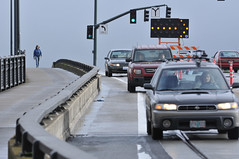
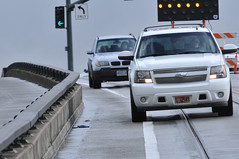
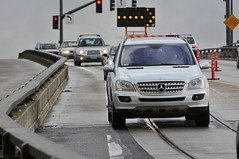
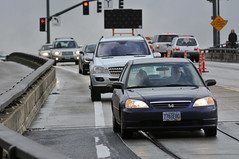


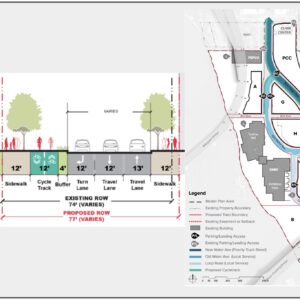
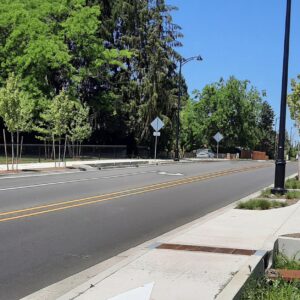
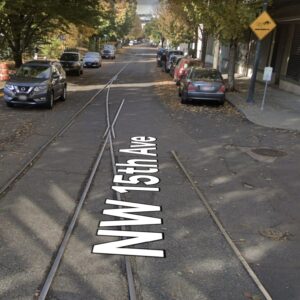
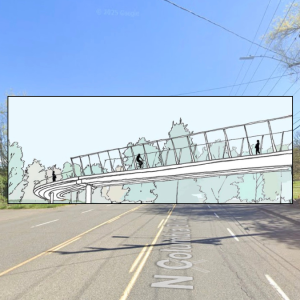
Thanks for reading.
BikePortland has served this community with independent community journalism since 2005. We rely on subscriptions from readers like you to survive. Your financial support is vital in keeping this valuable resource alive and well.
Please subscribe today to strengthen and expand our work.
I’ve biked this and driven it a couple times in the last week, and it’s a constant problem. And very dangerous to bicyclists.
The reason drivers straddle the tracks is that the tracks are slippery and you don’t have as much traction on them. Same reason bikers avoid them.
For the short-term fix, the city needs to move their pylons into the center lane (the center lane is now closed) so that cars can straddle the tracks *away* from the bike lane.
For new streetcar construction, the tracks shouldn’t be raised out of the roadway. When theyre flush with the roadway (like the MAX tracks going west over the Steel Bridge) you can drive on them no problem. Where they’re raised above the roadway (about 1/4″ in this case), they cause traction problems for cars.
Thanks for covering this,
Ted Buehler
bikists/cyclers
And a long term fix is to stop building rails in the road, install trolley buses, and pave over or rip out the existing rails.
Trolley Busses, are not nearly efficient enough, and are inconsistant, leading to lower ridership. BRT systems are often used by public transit opponents, to discredit public transportation. First the tear out the rails, and replace them with busses, when ridership drops, they say “see, no one’s using public transportation, therefore it should be defunded”.
Here’s what you sound like:
“And a long term fix is to stop building bike lanes on the road, install more lanes for cars, and pave over or rip out the existing bike lanes.”
Think again about what you’re saying. I would hope somebody posting on this website would at least understand that a comprehensive transportation system includes all types, cars, trucks, buses, bikes, and yes, even streetcars and trains.
The streetcar track spacing is very similar to the tire track width of most cars and driving directly on both rails produces an odd sensation that makes you feel the traction or steering control is poorer. This explains why people behave like this when there’s room to do so.
I think lanes with streetcar tracks should be given extra width so that drivers can straddle the tracks if necessary, or perhaps the tracks should be offset from center in the lane or both lane and tracks should be offset further from the bike lane.
The Lovejoy ramp and other streets have only so much space to go around though.
Thanks for bringing the issue up.
If you want the city to fix this before you some other bicyclist gets run down or sideswiped, I’d suggest sending a request to ” safe@portlandoregon.gov ” and ask that the problem be fixed.
I took a photo of the cars last week and sent them the photo and this message from my iPhone.
***********
“Construction pylons are encroaching on the westbound driving lane of Lovejoy Ave just west of Broadway. This is causing car traffic to encroach on the bike lane.
“Please move the pylons over so cars can comfortably travel in their own lane, or close the lane to westbound cars until it is possible to allow cars to navigate it without risking hitting bicyclists.”
***********
Remember folks, the squeaky wheel gets the grease!
Ted Buehler
The squeaky wheel sometimes gets replaced.
Is there any chance people might want to wait until after construction is done and see what happens then? Construction is difficult, and does not reflect normal conditions. Sacrifices are often made by all parties involved.
During construction they could have just closed the whole thing all together. It is tough to squeeze construction, cars, and bikes all into one spot…
As far as the suggestions so far, I like the one where we try to offset the tracks in the vehicle lanes. I *always* straddle the tracks in my cars. Driving on the tracks just is wonky (even the ones that are flush with the roadway). The problem is most noticeable in front wheel drive vehicles, and is even worse with my studless-traction tires (they seem to grab the rails more than regular tires).
Plus, wet tracks are slippery…
I think all modes can coexist easily.
As far as the whole “driving in a bike lane” is illegal thing, If you really want to push on that then drivers will push on the “bicycles required to use bike lane when present” thing. I think that it would be best for all to just relax and take it easy. I don’t know many auto drivers who encroach on the bike lane when bikes are there, although it gets more risky on downhill sections (like this one) as bikes can go faster than cars and “sneak up” on the cars.
I do think the track/lane offset needs to be better thought out but we will see when the final lanes are striped when the project is completed.
I don’t think that we can make every possible inch of infrastructure perfect for all modes. We can try to be a little bit reasonable…
I think that bike lanes in places like this where they get encroached on often could use more of that “bumpy” treatment – helps cars know the line on the pavement is there… And also more strategic use of the green thermoplastic – people who like to drive on white lines seem to notice the green more. Although I have seen drivers on the Yamhill/Morrison MAX line driving on their large round bumps completely obliviously – so we can only do so much without physically separated bike lanes. Heck, I have seen people drive over median curbs (in small low cars) just to get into a shopping center – so there are some people we just can’t reach… Bicycles just need to really watch out for those idiots – because all the lines, curbs, blinky lights and neon gear in the world don’t help make dumb people smart…
A bigger problem is the large buffered bike lanes on Oak downtown where drivers ALL THE TIME treat them like auto lanes. Today at lunch a person pulled into it and sat there for almost 5 minutes while waiting for a parking spot in front of Kenny&Zukes. Weather was really bad so there weren’t too many bikes out – but people are oblivious to the fact that it is even a bike lane, and all the markings are completely warn off and hard to see in the rain. Need more green. 🙂
You’re right, construction is temporary and presents unique problems that may not be there when completed. However, this is a long term construction project, and now is precisely the time to engage Streetcar & PBOT about paint, signage, meanders, etc. When the contractors are out on the scene, it’s much easier to get changes implemented. It’s also important that streets remain safe throughout the construction phase, I don’t think you’ll find much disagreement with that.
The Streetcar isn’t slated to run until 2013, in the meantime, the tracks are already on the ground and a thick blue line present on every portland bike map printed in the last 10 years has now been (rather quietly) decommissioned. Instead, we have an area that is now largely bike un-friendly. If we take the right steps, we can get many of these issues mitigated, and make the case that all future streetcar development should bring serious bike infrastructure alongside it, so we actually have bikeway improvements, not bikeway degradation.
as much as i will insist on taking the lane where the striped bike lane is unsafe, i disagree that there is a full analogy to motorists encroaching on the bike lane. even where the bike lane is not safe for use as a travel path, it is still available as a refuge, provided motorists are forbidden to enter.
Yo, been there done that. They’ll say “Sorry, you should have brought this up when it was still in the planning/construction process!”
If plans are on the drawing board, it’s pretty easy to shuffle lines around and fix looming problems.
After all the paint and tracks are on the road, it’s much more difficult…
Ted Buehler
That previous response was in response to valkraiders question to me
“Is there any chance people might want to wait until after construction is done and see what happens then?”
I’m still getting used to the board’s new “reply” feature
“I don’t know many auto drivers who encroach on the bike lane”
In the hillier and curvier parts of town (NW and SW hills) drivers constantly cut into bike lanes. I have come close to catastrophic crashes more times than I care to think about.
:pours another glass of wine:
Ted, do you know what those pylons are marking? I’m not too familiar with that stretch. I can see there are yellow lines marking off a center space between the opposing lanes of car traffic, and I’m wondering if that will eventually end up being space drivers can swerve into, safely away from the bike lane.
I’m just trying to get a fix on how much this obviously bad situation is being exacerbated by the pylons.
Thanks for taking action, I’ll follow your example.
When the Max train finally runs there, it will be right by the bike lane. At least cars can give a biker room; Max can’t.
This is a streetcar track, not a MAX track. (They look very similar in places, though.) Streetcars are actually narrower than MAX vehicles. Streetcar vehicles do not extend past the concrete trackway (which is visually distinguishable from the asphalt and other street markings), so streetcars will always, by design, give the pictured bike lane room.
I’d love to see a raised curb separating the bicycle lane from car traffic in this location. It wouldn’t have to be very high, an inch or so would probably do it. Similar to what keeps the cars off the sidewalk on the Hawthorne Bridge.
The next step up would be a physical barrier similar to what was installed on the Steel Bridge.
Smaller-scale options I can think of: above-ground reflectors, rumble strips or the bumps that are along the MAX tracks downtown. We have plenty of options to draw on.
I would argue that motor vehicles with an average tire width of say, 20cm, have more than enough stopping power even if all 4 tires are on a 4cm wide wet metal track. I’m guessing the folks are avoiding them car dance around a bit as it tracks in the groove.
I’ve always been opposed to curb separation of bike lanes for the simple reason that if a cyclist strays from his or her line and grazes the curb (say when passing or being passed by another cyclist) there’s a great likelihood they’ll go down.
Raising the lane a few inches entirely (copenhagen lane) would probably work quite well in this instance
Curb separation can definitely be dangerous for bicyclists. One solution is to use a mountable curb to discourage vehicle access without added threat to riders. The Cycle track on Cully will use this, as do a few other raised bike lanes in Oregon.
even before the tracks went in, it has never been appropriate to have a striped bike lane here, at least on the downhill. i have always ridden to the left of the bike lane here, and i will continue to do so.
exactly!
thanks to judge zusman’s ruling cyclists can now take the lane anywhere where there is a break in the bike lane (e.g. just about everywhere).
Jonathan, thanks for documenting this so well. I noticed the ‘straddle’ phenomenon a decade ago when tracks first went down on Northrup, which I use fairly regularly as a driver. My wheels would definitely slip if I rode on the tracks. I tend to straddle to the left on Northrup. I suspect that those who have suggested that the lane dimensions contribute to a rightward straddle on the ramp are correct.
are wrote
“i have always ridden to the left of the bike lane here, and i will continue to do so.”
are — Q 4 U — have you ridden the ramp since the streetcar tracks went in? You ride between the right-hand streetcar track and the white stripe?
And why do you find the bike lane inappropriate? Too narrow? Too high of a guardrail?
Before the tracks went in I would often take the lane just so I could go 20-25 mph (not safe in a 5′ bike lane with a concrete guardrail on one side) but if there was backed up traffic I liked having the option of bypassing the congestion in the bike lane.
Just looking for clarification.
ted, yes, i have, and yes, i still ride somewhat to the left of the bike lane stripe, and for the same reason: the lane is too narrow to share safely with an overtaking motorist. with the jersey barrier along the right edge, i don’t think it is correct to describe this as a five-foot lane.
near the bottom, as the cars begin to stack up for the light, i have often, but not always, moved into the bike lane so that i will not have to wait through two or three cycles for the backup to clear. now that lovejoy is one way after 9th, if i am intending to head south, i still prefer the left turn lane to the new copenhagen box, but frankly my only interest in lovejoy, unless i am heading north, was to get to 11th, so with that off the table i have begun to take broadway down from the bridge.
It is a common mistake, unfortunately, for motorists to straddle too far off of the tracks. It is only necessary to line up your tires so that they aren’t in contact with the rails, it is not necessary to be 2′ over and into someone else’s lane. (I’ve caught myself making this mistake a few times.)
I call it a mistake because I think it’s an issue of human perception — it’s a subjective thing. The driver “feels” that the tracks are an obstacle to be avoided, and so automatically gives a wide margin to the “obstacle” in the same manner that they’re expected to steer clear of bicyclists, pedestrians, etc. (we hope).
Another too-frequent problem is the habit of visually following the rails when they divert from lane markings, for example when the rails drift over to hug the curb at a station platform. At night, a motorist visually following the rails and also straddling too far to one side could wind up with a tire up on the sidewalk.
As a member of the Portland Streetcar Citizen’s Advisory Committee, I have suggested that streetcar platform edges all be painted bright white (or yellow, or whatever conforms to code) to stand out more… some of the platform edges (unlike MAX) are painted black for some reason. I didn’t hear back about that issue, I’ll bring it up again at our next meeting.
maybe when they remove all those cones and barricades at the top of the hill people will straddle the left rather than the right rail.
but my main comment would be that I hate to be confined to a narrow bike lane like that on downhills. With the railing on your right and the rails on your left, there’s really not enough space for cyclists to maneuver in this location, especially at speed on a downhill.
What do you think about barriers instead of curb separation, like they did on the new Vancouver BC bike lanes?
http://www.beyondrobson.com/city/2010/03/more_on_vancouvers_latest_bike_lane/
Just as bad as curbs?
I don’t really have an opinion. I mean, looking at Jonathan’s pictures here, the first thing that pops into my mind is some kind of concrete barrier, but I know some riders hate being boxed into a bike lane. And it’s a much narrower space than what they have in Vancouver BC.
Whoops, this was meant to be a reply to “JAT in Seattle.” (Still getting the hang of the new comments, I guess :))
I think the barrier (as opposed to a curb) is better where the road permits the bike lane to be wide enough (which is rare…)
My belief (at odds with OR law, I know) is that bike lanes on regular roads should be permissive use lanes rather than mandatory. We don’t require carpools to use the carpool lane, but they may. Likewise I shouldn’t have to use a bike lane when I feel it’s less safe (or less expeditious) than the regular travel lane.
Gravel, standing water, significant downhill slope are all regularly occurrences that make many bike lanes unsafe.
(I’m still getting the hang of the new comments as well.)
Yep, I definitely agree bike lanes should be optional.
And I also appreciate the feeling of safety provided by the barriers like the ones in that Vancouver BC project (and the fact that they only work with a wide enough lane). While I’m pretty comfortable riding in traffic, I’ve never quite managed to shake my paranoia about cars overtaking me. A constant “who’s trying to kill me?” state of alert I think I picked up in a motorcycle safety course I took in my mid-20’s. It certainly helps me relate to those “interested but concerned” riders – or potential riders – who would likely look upon these photos with a distinct sense of anxiety.
Ground reflectors are a simple, cost-effective solution. People hate driving on those little reflective bumps, and at night (most) people instinctively pay attention to them, so just have the city glue them along the edge of the bike lane. They couldn’t be very expensive. I’d like to see them installed along the edge of every bike lane, but putting them in problem areas where drivers tend to drift into the bike lane would be a good start.
reflective bumps are even worse for cyclists, please, please don’t suggest lining any bike lanes with them
thanks for documenting it J-man!
Jonathan wrote
“Before you comment, please realize I do not think this is the most pressing transportation safety concern in our city.”
I kinda differ on this.
I think that “the most pressing concern” is that small threats to bicyclist and pedestrian safety are not addressed. Because they’re seen as “secondary” somehow to some problem that covers more geography, will cost more to fix, etc.
But really, Portland’s bicycle infrastructure was built block by block, lane by lane, experiment by experiment.
If can just as easily be taken away through the same process.
The streetcar project takes a many small chunks out of Portland’s “bikability.” So do lots of other projects. And whether folks like it or not, fighting back on a case by case basis is an important element to not losing ground. The 2030 Bike Plan is a fabulous document, a blueprint for a great Bicycle Future, but if we don’t complain when it is left sitting on a shelf and bikeway rideability is downgraded, we’re not going to get to that future anytime soon.
Just my $0.02 That’s why I’m passionate about small projects, and I think this is a BIG small project. Lovejoy is integral to anyone going from N Portland to NW Portland. No way around it.
Again, thanks for covering these issues, but don’t downplay them!
Ted Buehler
Jonathon had to add that note because it seems like every time he posts about any bicycle safety issue there is always at least one comment complaining that the post is whining about something inconsequential.
As PDXCyclist says, my disclaimer was more an attempt to thwart the “Cyclists are a bunch of whiners” comments and less of an attempt to minimize the importance of this issue.
.
In my old car, the tracks would catch the front tires. But the car was rear wheel drive and this caused quite a few issues. More then once I lost control, swinging in to the other lane, or once finding myself sliding at an angle down the street.
My new car still has the same issue, but is nowhere near as bad.
This will be more of an issue with older cars, Their steering seems fine until they run on top of the tracks which throw them around. Also the tracks don’t go straight down the car lane, they meander left and right forcing you to go from straddling right to straddling left in an unnatural driving pattern that will someday be trouble for some unfortunate soul. This will be even worse when we have ice or frost on the tracks. I think the rest of this project may have some similar issues also.
Ted B wrote:
“The streetcar project takes a many small chunks out of Portland’s ‘bikability.’ So do lots of other projects. And whether folks like it or not, fighting back on a case by case basis is an important element to not losing ground.”
(I hear what you’re saying; but do you realize what a poor sales pitch that makes for encouraging new voices in bicycle activism?)
If the best we can hope for is to hold our ground, that hold will become more tenuous as the city’s population grows and more demands are made on an aging infrastructure that doesn’t have the resources to truly keep pace with the growth — and with the continued public demand for single-occupant car use. The 2030 plan has some great stuff in it but I fear that in the end very little of it will actually be realized in a serious way before plans are made to write the next plan.
It almost seems easier (and less stressful) to use the sidewalk anytime a bicyclist doesn’t feel safe on the road. Raised cycletracks are not going to pop up everywhere we’d like to see them (and for someone of us, cycletracks will never be enough anyway).
This is typical driver behavior and I doubt it has much, if anything, to do with the streetcar tracks. Throughout the City you can see the bike lane markings warn through, particularly at curves, where drivers tend to encroach in the bike lane to take advantage of the space.
As Jonathan observed, this behavior practically disappears when someone’s actually biking in the lane. I commonly encounter drivers crossing over the line on the freeway and other multi-lane roads when they aren’t actually making lane changes and they correct themselves back into the lane they started.
I drive on the streetcar tracks on MLK/Grand every now and then, and haven’t noticed anything unusual about the traction, but then, I drive at or below the speed limit, particularly when it’s raining and dark.
“The streetcar project takes a many small chunks out of Portland’s ‘bikability.’ So do lots of other projects. And whether folks like it or not, fighting back on a case by case basis is an important element to not losing ground.”
(I hear what you’re saying; but do you realize what a poor sales pitch that makes for encouraging new voices in bicycle activism?)
I think what’s going on here is improving our bicycle network in multiple dimensions. For most of the history of our effort we’ve worked on expanding the reach of the network (and we definitely still are). But what Ted and AROW are doing here is looking in very fine detail at the fitness and safety of various parts of the network and that’s going to be very valuable in attracting the “interested but concerned” segment of potential riders.
And as a streetcar advocate this process is a great learning opportunity. Every project has taught us how to create more bike-friendly designs. We’ve learned how to avoid the gross-level mistakes (like putting a bike lane between parked cars and tracks). This kind of critique is going to inform the next level of depth in our learning.
every project has also made major mistakes that are now cast in concrete, and which will continue to be unacceptable for years to come.
was it really worth it? I don’t think so.
I was out running errands and tried driving on the rails when coming up NE Grand from Couch to Broadway. (’87 Toyota, front wheel drive)
My steering wheel jiggled as I drove on the tracks. And whenever I drove onto or off of the tracks the car jumped around a bit.
It’s definitely harder to control a car on tracks than it is on pavement. So I see why people don’t want to do it. Obviously, it’s a concern for bicyclist safety if a street has been layed out so drivers are forced to either drive with their steering wheel jiggling or drive in the bike lane…
Also, in response to Chris Smith’s comment, yes, it’s hard to follow the lane and not the tracks when the tracks swerve over to a raised-curb station. Maybe a white “Fog Line” painted at the parking lane, and on the pavement in front of the station stop will help drivers maintain their position in the lane while the streetcar tracks wander on and off-center. And yes, white reflectors on the station platform edge itself to give folks something to shy away from as they drive along.
Ted Buehler
Drivers should absolutely avoid driving on the tracks for the same reason bikes should – they’re slippery. Who wants a car losing control and swerving into a cyclist?
I also see absolutely no problem with a car entering an empty bike lane for a bit. The very pictures show that when a bike is using it, the vehicle straddled in the other direction.
A bike lane is just a painted line, not the end of the universe. I’ve never understood why people take painted lines to be the word of God. Sometimes you’re between the lines, sometimes you’re not, it really isn’t a big deal.
I would however set the tracks slightly closer to the center line in the future.
“… I also see absolutely no problem with a car entering an empty bike lane for a bit. …” JJJ
It’s a bad practice, because from motor vehicle operators, it requires them to signal in advance of moving into the bike lane, and look carefully for bike traffic before actually moving into the bike lane.
A bike with rider in a bike lane, is easier to miss seeing than is a car in a main travel lane. If motor vehicle operators feel the need to straddle the tracks, rather than drive directly on them, they should do so on the side of the tracks away from the bike lanes.
Sure, that reduces the passing clearance of adjoining main travel lanes, but this is really only an issue for cars and larger vehicles, that only need to perhaps slow down a bit and drive more carefully to deal with this problem.
How about doing like ODOT did in Tigard and add *SMALL* turtles to the outside of the bike lane? (SB lane, SW HALL, between SW Hunziker Rd. and SW Commercial)
http://www.flickr.com/photos/ufobike/3841489571/
It has cut down on the intrusions that I’ve experienced here.
Slight correction, and better photo…
Between SW Scoffins St. & SW Commercial St.
http://www.flickr.com/photos/ufobike/3841483193
If nothing else, it lets you hear when the car is TOO DAMN Close.
I’m unfamiliar with the small “turtles” K’Tesh mentions and pictures. I realize the drawbacks to other common barriers between bike and motor vehicle lanes (such as raised curbs, large bumps, vertical barriers).
So I’m curious to learn more about the effectiveness and safety (for both an intentionally and unintentionally veering bicycle) of these small “turtles”. Besides the location K’Tesh cites, where else have these been used to discourage motor vehicles from incursions into the bike lane?
It would be useful to understand the effectiveness of these before advocating to traffic planners/engineers for their use.
Here’s a “Before” picture, showing the intrusion problem I experienced in Tigard.
http://www.flickr.com/photos/ufobike/2658020347/
It’s part of my “KEEP OFF The Bike Lane!!! Tigard, OR” Set.
http://www.flickr.com/photos/ufobike/sets/72157606113470671
Maybe:
City paint the bike lane green–similar to the bike boxes.
OR
Ride the sidewalk.
Tulsa takin’ notes.
Also take a look at Lovejoy, heading toward the bridge ramp, between NW 10th and 9th – the bikelane seems to disappear where there is a curb extension at what looks like a future streetcar stop. What’s up with that? Another one of those silly arrangements where the bicyclist is supposed to go onto the sidewalk right at the point where you can expect the most pedestrians?
I’d start with turtles, then move to more aggressive measures if needed. Turtles at least let the riders move in and out of the driving lanes & let both riders and drivers know they’re enroaching.
Then every 15ft or so leave out a cpl for merging
I’ve seen this along hwy’s touring in other states.
Yes there is an opportunity for placing RPMs or buttons (or strategic wands) on the car lane side to reinforce drivers to keep clear of the bike lane…sadly this design issue was not given enough weight by the project engineers (value engineered away?) as there seems to have been some expectation of it – it could have been easily managed by a concrete raised bikelane. (Perhaps a lift of black asphalt can still be added to raise the lane…with more frequent bike stencils.)
And this might be a good place for police enforcement of the bike lane issue.
Thanks for bringing up this issue on the main page. My daily commute takes me across the Broadway Bridge and I have noticed this same traffic behaviour. When heading east and climbing the hill to the bridge bikes need to keep to the left side of the bike lane because of the clogged drain on 9th and the accumulation of leaves and other debris. This puts us closer to the cars and leaves a smaller margin of safety.
I agree that most cars straddle the rails and I completely understand; the couple of times I have driven my van I hated the feel of 4 tires on the tracks. Most cars are careful not to stray too far into the bike lane and will move out of it if they notice a bike. The problem is not with the majority of drivers though. It is the smaller handfull who are simply not aware of bikes that are now put in a situation where it is even more likely that they will hurt somebody.
A policy of a raised curb or raised bike path would of solved this problem before it even happened.
I drove through here eastbound where here used to be a bike lane and a dude was there, trying to bike between the rails and the curb which is quite tight. I feel like there should really be more sign-age or way-finding to get bikes out of this situation. In the story, Jonathan mentions that cars move over if there is a biker, but that doesn’t matter if the biker is coming down the hill to a line of stopped cars, half of them will be in the bike lane.
All of that being said… The obvious solution here is to combine the bike and ped paths into one like there is over the bridge.
I like driving on streetcar tracks. I go real slow, and put my tires right on the rails. Gives a real smooth ride. My tires don’t slip, either.
Totally. The people that are straddling are going too fast and/or don’t know how to drive. Yes, your tires might slip on the rails if you do something sudden, but once they slip off the rails they’ll bite in again. Staying on the tracks takes some effort, you don’t need to deliberately avoid them. A four wheeled car with no balance issues and tires that don’t fit into the tracks grooves has nothing to fear on the streetcar lines.
But what do I know, I bike down NW 10th between the rails too.
I know at least 20 people who don’t ride bikes but do ride the streetcar who would say it was worth it. (anecdotal, I know – but I work at an office on the streetcar line)
There are people who don’t ride bicycles. Some of them would like to get around without a car too!
And you sound like a paid spokesperson for the streetcar.
The website is BikePortland.org. Not ComprehensiveTransportationSystemPortland.org
I would hope somebody posting on this website would be interested in optimizing the transportation system for bicyclists.
I guess no one liked the idea of sidestepping all of the fun bike infrastructure talk by the simply slowing down and riding the side walk. You’re forced to go right at the bottom of the bridge anyways. Just slow down, watch for pedestrians, check your left shoulder and merge onto the road. Easy, no unnecessary public dollars spent. Just train the yourself. Have you noticed the sign that warns bikers about the light signal? Maybe it’s us that needs to adapt. I ride this every morning, have been for 2 years… Just slow down and look for pedestrians and you’ll be fine! Totally safe!
I really don’t understand why PBOT is allowed to “experiment” and “learn from their mistakes” every time one of their projects ends up making a mess out the public right of way. We pay engineers and government officials to provide solutions, not learn how to do their jobs on the public dime. My gut tells me there are always good or acceptable solutions to a difficult problem. That it was difficult is not an excuse for a professional to make a mistake, especially when we’re talking about people’s health and safety. If you want to design a right of way that is supposed to support streetcars, cars, trucks, bikes, and pedestrians then I hope you have your thinking cap on, because that it indeed a hard one to tackle.